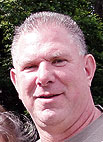
Larry and his son, Eric Walker, of Willow Springs Ranch near Prairie Grove, Ark., like Maine-Anjou qualities when it comes to cross-breeding their Angus cattle.
They also like the idea of diversification, while keeping focused on how cattle do at the feedlot.
“Not every calf is a show calf,” Larry said.
They take this balanced approach to keeping the qualities and traits of the Maine-Anjou breed in their herd – while also using a few Simmental and Angus bulls – and watching the bottom line at the feedlot.
“Dad and I are big believers in cross-breeding cattle,” Eric said.
The bottom line with the injection of Maine-Anjou blood into the herd has been more pounds of beef with less grain input, he said.
The Walkers keep a herd of 520 momma cows on their land and leased land near Prairie Grove. The farm includes 800 owned and 70 leased acres; the Walkers have the use of some government-owned land that is part of the Ozark National Forest during part of the year.
Of the 520 momma cows, 400 are Angus, the rest are Maine-Anjou. Thirteen of the farm’s 15 bulls are Maine-Anjou; the other three are Angus or Simmental.
To be registered, cattle must be 75 percent Maine-Anjou. But the American Maine-Anjou Association has a program called the Mainetainer that allows cattlemen to register 25- to 75-percent Maine-Anjous.
The Walkers first started using the breed in the 1980s. During the mid-1990s, they primarily used Angus, but began to notice calf crops that were not performing as well as they had been with the Maine-Anjou injection.
“That’s when we decided we needed to put some hybrid vigor back into the cattle,” Eric said.
They bought four Maine-Anjou bulls about six years ago from a breeder in South Dakota.
The goal is to have the entire herd be “somewhere between 25 and 75 percent Maine-Anjou,” Eric said.
The Walkers are members of the American Maine-Anjou Association. Eric Walker heads up the Arkansas Maine-Anjou Junior Association and assists those ages 5-21 with their show projects. It’s a good fit, because Eric’s children are involved in showing cattle.
“We show because it’s a neat family activity,” Eric said.
His son Mason, 11, showed the reserve grand champion Mainetainer Heifer this year at the National Maine-Anjou Heifer Show in Spencer, Iowa. Daughters Whitney, 9, and Catelyn, 7, also show.
“What makes crossing Maine-Anjou with Angus appealing is not only is it good for kids to show because Maine-Anjous are known for their docile temperament,” Eric said, “but also the breed adds a hybrid vigor to feeder calves.” The Walkers retain ownership of the calves when they go to the feedlot.
The farm will also continue the practice of cross-breeding with Simmental.
Replacement heifers have been artificially inseminated with a Maine-Anjou bull the Walkers share ownership of in South Dakota named Mercedes Benz. Bulls on the Walkers’ land are used for coverage. The heifers themselves are either Maine-Anjou-Angus or Maine-Anjou-Simmental crosses. The result will be a three-way cross, or Mainetainer; some of the two-way crosses will also be maintained, Eric said.
The goal for the farm is yearly to sell 25 to 30 high-end steers for showing; 50 to 60 replacement heifers; 50 to 60 bred heifers in the late fall, and 20 to 30 high quality bulls.
“Ultimately, diversity is what we, as a farm, have to look at,” Eric said.
At the same time, the Walkers realize that feeder calves are the bulk of the business.
“We have to keep in mind that cattle are designed to go to the feedlot,” Eric said. “Everything else follows from that.”







